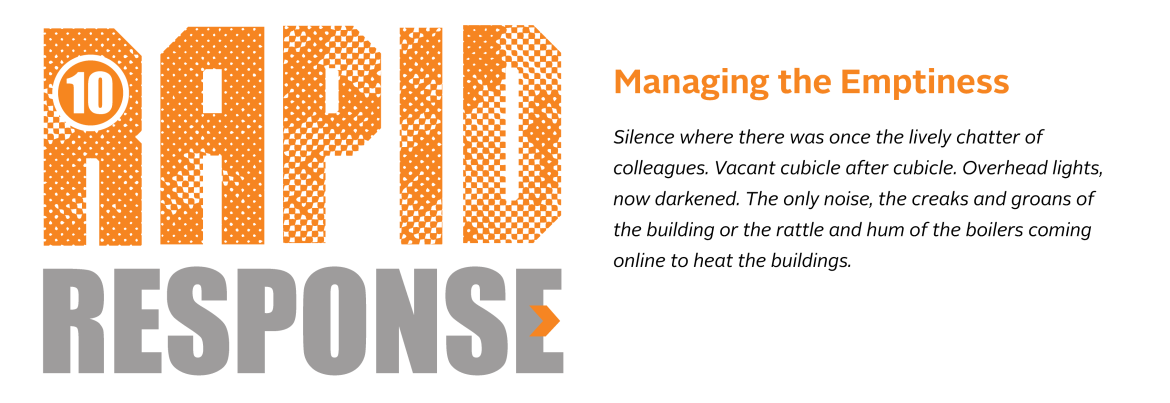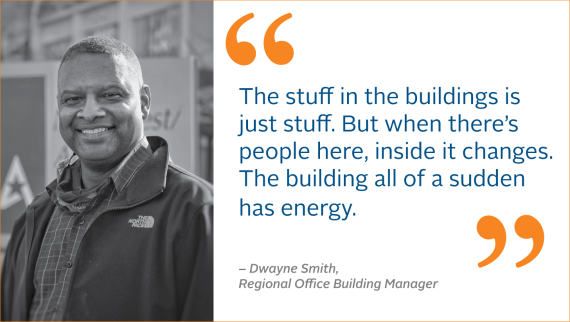R10 Rapid Response 5

 Read image text description
Read image text description
Only occasional human contact and when it happens, people take precautions. Masks. Distancing.
Sounds like the opening of a horror movie, but it’s actually what many of GSA’s federal offices are like during the time of mandatory telework — empty spaces that still need attention and upkeep.
As GSA rapidly transitioned to mandatory telework across the nation and within days of the COVID pandemic starting to take its toll, building managers and the federal office charged with delivering administrative services to the people in these buildings were left wondering — what now?
When the first identified COVID exposure hit a federal building in Western Washington, GSA was developing cleaning policies and working toward what would eventually become mandatory telework for all federal workers in Region 10.
This meant the once busy federal offices would almost, overnight, become empty.
“We quickly developed protocols on how we can support our customers knowing they can’t come in any longer,” said Kurt Hammond, Supervisory Workplace Services Specialist for the Office of Administrative Services with GSA. “I wasn’t sure how busy we’d be because of this. We soon found out.”
Hammond and his team worked out of the GSA Regional Office Building for Region 10 in Auburn, Washington. Like many of his counterparts across the country, the daily work shifted from in-person requests for services to moving everything online.
In Region 10, this meant his staff needed to change their way of doing business almost overnight… everything from mailroom operations and setting up processes allowing GSA staff a way to digitally sign for packages to offering printing and scanning services to those working from home.
His team was also tasked with preparing the office space for an eventual return by GSA colleagues. Hammond and his crew had to get hand-sanitizing supplies, distribute masks to regional locations and figure out how to create new working areas and pathways that factored in social distancing when people returned.
He and his team also had to deal with the quiet.
“It’s like a zombie movie in here - without the zombies,” Hammond said of the hundreds of empty work spaces that surround his desk. “You have to get used to the quiet.”
In those quiet times, Hammond assembled the hand-sanitizing stations, and walked the floor to learn how to best develop new paths to ensure social distancing. He rode the elevators to determine how many people could safely get on at one time and toured the building to determine where to place signs reminding staff about wearing masks, hand washing, and social distancing.
Regional Office Building Manager, Dwayne Smith was also in the building keeping it running in spite of so few on-site colleagues. Keeping social distancing in mind, Smith and Hammond would wave to each other from a distance - one of the few people they respectively saw during their daily work.
For some, seeing the faces of colleagues is a distant memory especially when you have more than 586,000 square miles of Alaska territory to cover for the federal government and there’s only two of you.
Tom Deakins, Alaska Field Office Manager can go days at times without seeing anyone other than his office staff in Anchorage, particularly when he travels around to manage the nearly empty federal buildings throughout the state.
In spite of the telework requirements now facing federal employees, the buildings Deakins manages still have needs and in the sub-arctic temperatures, getting to those fixes can be tricky when there’s no one onsite to repair damage.
Deakins has even seen cleaning becoming a challenge after a COVID exposure in some of the more remote locations. A federal agency occupying one of his managed buildings even had to fly new staff in to clean after an exposure because everyone onsite was in quarantine.
“It really became about risk analysis,” Deakins said. “Every day you take care of the most pressing issues, then move on to the next in the order of severity.”
Triaging these challenges isn’t new to Deakins, but doing it in a pandemic is something he never envisioned. He also said the human element to all of this, the stress associated with pandemic, had to be carefully managed.
“We have to manage burnout and the new workload on everyone,” Deakins said. “Letting everyone know I was there for them, was and still is important.”
When the pace slows, building managers take advantage of it by catching up on maintenance work that would have been otherwise delayed because of the typical daily workloads when the buildings were occupied. But the lack of on-site staff and the cyclical rate of work allowed some to make progress on pending building maintenance projects. They say this is important work because it keeps the buildings in good shape and saves taxpayer money in the long run.
Not everyone had silence and empty buildings. Some had quite the opposite experience. Portland, Oregon, federal Building Manager John Gregory traded seeing the traditional business suits and briefcases for armed officers in riot gear, fully loaded weapons, and tear gas canisters. Gregory works in the Edith Green Wendell Wyatt (EGWW) building and saw the workforce that occupies the building drastically change.
Heralded internationally for its unique design, the EGWW building is a jewel among Portland’s downtown core. When the mandatory telework temporarily emptied the building, Gregory believed he could catch up on some maintenance work inside.
While the mandatory telework briefly quieted his building from federal workers, they were soon replaced by Federal Protective Service officers who located there to set up their Emergency Command Center. Portland’s federal buildings were the target during almost-nightly protests leaving Gregory and his counterparts spending their time replacing glass and removing spray painted messages in addition to managing the COVID response.
“It was definitely a strange change from what it’s normally like,” said Gregory. “Never thought my biggest challenge would be to board up windows and protect the building.”
“It’s depressing to see all this,” Gregory added. “We’re down here seven days a week checking the buildings for the latest damage to fix.”

At a couple of points during the past year, Gregory said there were as many as 300 officers in the building. Overall, his occupancy has been running 12 percent, far lower than when it was populated by the many federal agencies who have space in the building and yet, still far more than most of the building managers who rarely see people in their buildings.
“Our locations are pretty much ghost towns,” said Deakins of his Alaska spaces.
And when these managers do see people, it can sometimes be startling. Smith recalls working most of the day in the regional office building and after several trips down the same hall a co-worker sitting there in a corner said “Hi.”
“I had walked past her four of five times then she said hi,” Smith said. “I nearly jumped out of my shoes.”
Other managers talk of similar experiences being in buildings and running into coworkers they weren’t expecting to see. And the managers all agree, they miss the daily human interaction that was such an important element to their job pre-COVID. No one knows the date federal workers will return to their offices and what that return will look like when they do. But to building managers like Smith, the space isn’t the same without the people.
“The stuff in the buildings is just stuff,” Smith added. “But when there’s people here, inside it changes. The building all of a sudden has energy.”
Story and Photos by:
Chad Hutson, Public Affairs Officer
Layout by: Cynthia Henry, Graphic Designer
Read more of the GSA “R10 Rapid Response” series:
- Part 1: R10’s Industrial Hygienist Looks Back Over a Demanding Year
- Part 2: The Air that We Breathe
- Part 3: ROB on the Move…Wait
- Part 4: Purchasing During a Pandemic
- Part 5: Managing the Emptiness

 U.S. General Services Administration
U.S. General Services Administration